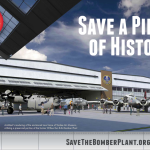The recent articles about the “Save The Bomber Plant” campaign made us think about the several other plants still existing in the United States. In the wake of Pearl Harbor, the president set staggering goals for the nation’s factories: 60,000 aircraft in 1942 and 125,000 in 1943; 120,000 tanks in the same time period and 55,000 antiaircraft guns. In an attempt to coordinate government war agencies Roosevelt created the War Production Board in 1942 and later in 1943 the Office of War Mobilization. To raise money for defense, the government relied on a number of techniques — calling on the American people to ration certain commodities, generating more tax revenue by lowering the personal exemption and selling government war bonds to individuals and financial institutions. All of these methods served to provide the government with revenue and at the same time keep inflation under control.
“I need not repeat the figures. The facts speak for themselves…. These men could not have been armed and equipped as they are had it not been for the miracle of production here at home. The production which has flowed from the country to all the battlefronts of the world has been due to the efforts of American business, American labor, and American farmers, working together as a patriotic team.”
–President Franklin D. Roosevelt, Navy Day speech, October 27, 1944
Raising an armed force was just part of America’s war effort. That force had to be supplied with the uniforms, guns, tanks, ships, warplanes, and other weapons and equipment needed to fight. With its vast human and material resources, the United States had the potential to supply both itself and its allies. But first the American economy had to be converted to war production.War production profoundly changed American industry. Companies already engaged in defense work expanded. Others, like the automobile industry, were transformed completely. In 1941, more than three million cars were manufactured in the United States. Only 139 more were made during the entire war. Instead, Chrysler made fuselages. General Motors made airplane engines, guns, trucks and tanks. Packard made Rolls-Royce engines for the British air force. And at its vast Willow Run plant in Ypsilanti, Michigan, the Ford Motor Company performed something like a miracle 24-hours a day. The average Ford car had some 15,000 parts. The B-24 Liberator long-range bomber had 1,550,000. One came off the line every 63 minutes.
Thanks to David D Jackson of Warbirds and Airshows we were able to obtain recent pictures of some of the factories that helped America win the war.
Bell at Marietta, GA B-29 Plant (Lockheed since 1951) Air Force Plant #6 – This plant built at total of 668 B-29s during WWII. 357 B-29s (One reference indicates these were B-29As. However, the B-29A was only built at Boeing Renton, WA. See Below.) and 311 B-29Bs. Marietta was the only plant that built the B model, which was stripped of turrets, guns and armor except for the tail position and were optimized for low level night bombing and were 7,0000 pounds lighter and ten miles an hour faster than the normal B-29.
David did such am amazing job please visit his website to see more pictures of these factories. Click HERE . During the research for this article we came across another interesting website which covers the ruins of the Third Reich historical sites. Click HERE.


























